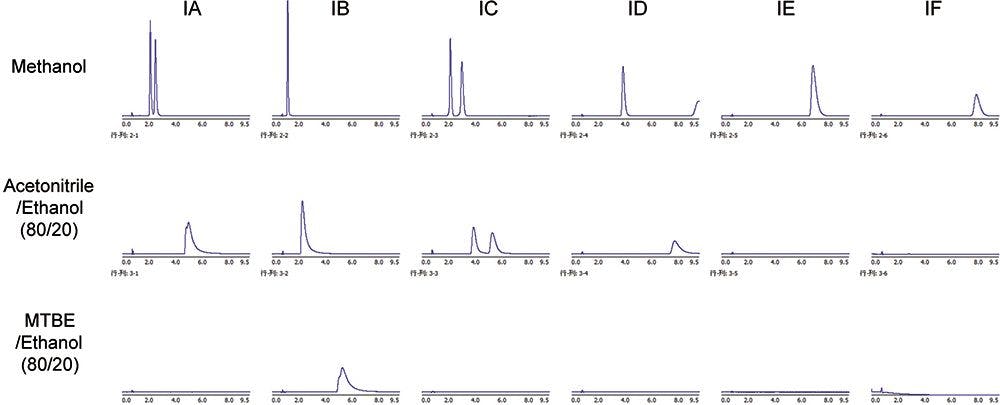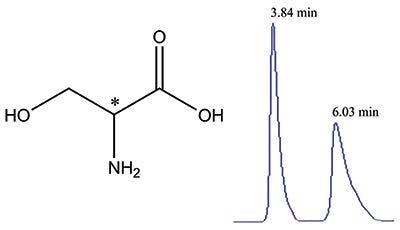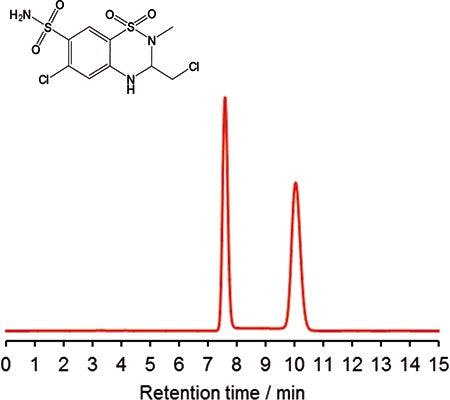DAR Analysis of Antibody Drug Conjugates Using a TSKgel HIC Column
The Application Notebook
The monoclonal antibody (mAb) drug market has continued to expand in recent years, and several of the top 10 blockbuster antibody drugs currently on the market include antibody drug conjugates (ADCs). Antibodies, when conjugated with cell-killing cytotoxic drugs, are called antibody drug conjugates. These drugs are designed to be used for chemotherapeutic cancer treatments. ADCs have a structure in which a low molecular weight cytotoxic drug is chemically bonded to an antibody. Because there are numerous binding sites for a low molecular weight drug on the antibody (Cys, Lys residues, etc.), heterogeneity arises with respect to the number of bonds and binding sites. It is necessary to study in detail the effect that this heterogeneity has on the medicinal effects and safety of drugs containing ADCs. Since low molecular weight drugs are strongly hydrophobic, differences in hydrophobicity of antibodies arise when the bonding number of these types of drugs differs. This property can be utilized to determine the drug-to-antibody ratio (DAR) by hydrophobic interaction chromatography (HIC). In HIC, a weakly non-polar stationary phase is used with an aqueous mobile phase containing a high concentration of a chaotropic salt. The technique is mainly applied to the separation of biomolecules, such as proteins, which are eluted by gradually reducing the salt concentration.
In this application note, an ADC was separated using a TSKgel Butyl-NPR column, the least hydrophobic of the TSKgel HIC columns. TSKgel HIC columns consist of polymethacrylate based material and a choice of three ligands (butyl, ether, and phenyl) with varied hydrophobicities from low to high, respectively. TSKgel Butyl-NPR is the best choice for high-speed separations with excellent recovery, even for more hydrophobic samples. The non-porous resin requires lower sample loading and leads to faster analysis time because the binding kinetics occur only on the bead's surface. The ultra-efficient 2.5 µm particles allow for fast and highly efficient separations. Thus, the TSKgel Butyl-NPR columns (4.6 mm ID à 3.5 cm and 10 cm) are ideal for time-critical quality control (QC) analysis or sample-limited applications. Because of the polymethacrylate based material, the TSKgel Butyl-NPR columns are stable in either acid or caustic cleaning regimes up to 1 mol/L.
An ADC (trastuzumab-vcMMAE) consisting of an antineoplastic drug (monomethyl auristatin E, MMAE) bonded via a linker to trastuzumab was used in this application note. Hence, an organic solvent (2-propanol) was added to eluent B for optimizing the elution of ADC peaks.
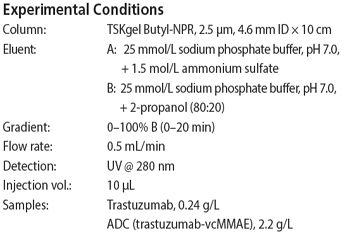
Results and Discussion
Both unconjugated monoclonal antibody (trastuzumab) and drug-conjugated trastuzumab (trastuzumab-vcMMAE) samples were independently injected onto a TSKgel Butyl-NPR, 2.5 µm, 4.6 mm ID à 10 cm column. After samples were injected onto the column, they were eluted with the organic solvent mixed in with a low concentration of sodium phosphate buffer, as shown in the experimental conditions.
The unconjugated trastuzumab sample was eluted as a major single peak at approximately 9.5 min (Figure 1, upper panel). This single peak indicated that the unconjugated trastuzumab consisted of mostly homogeneous molecules. The profile of the drug-conjugated trastuzumab (an ADC) exhibited well-resolved peaks with different retention times than that of the unconjugated drug and with baseline separation (Figure 1, lower panel). These well-resolved peaks were suggested to have different drug-to-antibody ratio (DAR). These peaks corresponded to DAR ranging from 0 to 8, estimated based on the mobility of the peaks. The heterogeneity of this sample was due to the addition of different drug loads. Consequently, this caused a decrease in mobility which resulted in differing elution times; the lower drug-loaded peaks eluted first and the higher drug-loaded peaks eluted later.
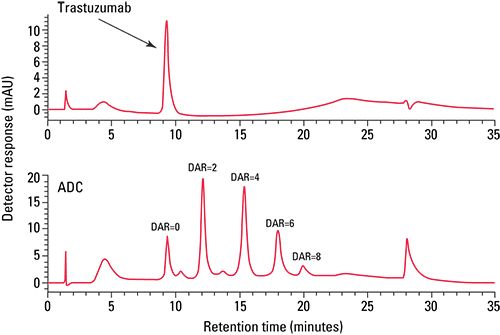
Figure 1: Analysis of unconjugated trastuzumab (upper panel) and drug-conjugated trastuzumab (lower panel) using TSKgel Butyl-NPR column.
The ADC peak with a retention time of 9.5 min displayed the same retention time as the unconjugated trastuzumab peak (compare Figure 1 lower panel to upper panel). The retention time similarity of the two peaks indicated that it contained a group of unconjugated trastuzumab; therefore, it had the same mobility (retention time) as that of the unconjugated trastuzumab. This peak was called DAR = 0. When trastuzumab was conjugated with 2 cell-killing drugs, it eluted later than the non-conjugated trastuzumab and was called DAR = 2. DARs = 4, 6, and 8 peaks were labeled due their retention times, respectively.
Based on the baseline resolution of these peaks, with further method optimization (including modification of gradients, analysis time, and flow rates), analysis time can be significantly reduced. Indeed, the analysis time could be reduced by 50%.
Conclusion
Both unconjugated and drug-conjugated trastuzumab samples were successfully separated with baseline resolution using a TSKgel Butyl-NPR column. The baseline resolution enabled an easy integration and quantification of different drug payloads in ADC characterization. Using a modified elution buffer (mixture of phosphate and organic solvent), the DAR peak can be easily collected for LCâMS analysis. With 2.5 µm particles and 4.6 mm ID à 3.5 cm and 10 cm lengths, TSKgel Butyl-NPR columns can be used with both conventional HPLC and UHPLC systems.
Tosoh Bioscience and TSKgel are registered trademarks of Tosoh Corporation.

Tosoh Bioscience LLC
3604 Horizon Drive, Suite 100, King of Prussia, PA 19406
tel. (484) 805-1219, fax (610) 272-3028
Website: www.tosohbioscience.com
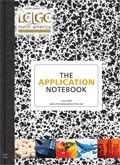
SEC-MALS of Antibody Therapeutics—A Robust Method for In-Depth Sample Characterization
June 1st 2022Monoclonal antibodies (mAbs) are effective therapeutics for cancers, auto-immune diseases, viral infections, and other diseases. Recent developments in antibody therapeutics aim to add more specific binding regions (bi- and multi-specificity) to increase their effectiveness and/or to downsize the molecule to the specific binding regions (for example, scFv or Fab fragment) to achieve better penetration of the tissue. As the molecule gets more complex, the possible high and low molecular weight (H/LMW) impurities become more complex, too. In order to accurately analyze the various species, more advanced detection than ultraviolet (UV) is required to characterize a mAb sample.

.png&w=3840&q=75)

.png&w=3840&q=75)



.png&w=3840&q=75)



.png&w=3840&q=75)


